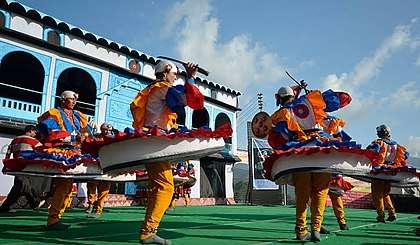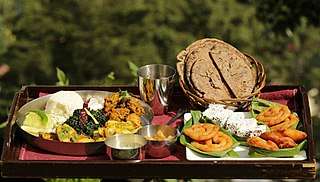Kumaoni people
Kumauni or Kumaoni are people from the Kumaon region of the Indian state of Uttarakhand. Kumaoni is addressed to person having origin in Kumaon region. The word Kumain is a direct derivative of Kumaoni.[1]
| Regions with significant populations | |
|---|---|
| Languages | |
| Kumaoni | |
| Religion | |
| Related ethnic groups | |
| Khas people |
They include all those who speak the Kumaoni language or any of its numerous dialects, living in the Almora, Bageshwar, Champawat, Pithoragarh, Nainital, Dehradun, Udham Singh Nagar, districts of Uttarakhand, India and Doti, Khaptad in Nepal.
History
The history of Kumaon is older than that of Ramayana and Mahabharata. Worshipping Lord Vishnu and lord shiva is predominant in this region, according to skunda purana. Kumaon is believed to be the Birth place of Kurma avtar of Hindu god Vishnu.[2]
Kurmanchal Kingdom
Kurmanchal kingdom was a medieval kingdom of kumaon. it was established by Vasudeo katyuri and capital was Baijnath, it was the one of the oldest Himalayan kingdoms and unified most of the Himalayas and was extended from Sikkim in the east to Kabul in the west at its peak, after fall of the kingdom it was divided in 8 different princely states. The next ruling clan of Kumaon was 'Chands' the dynasty at its peak controlled Tons to Karnail river. Kumaon was one of the few countries of South Asia that were never ruled or conquered by any Muslim dynasties.[3]
British Raj

There was widespread opposition to the British rule in various parts of Kumaon. The Kumaoni people, especially from the Champawat District, rose in rebellion against the British during the Indian Rebellion of 1857. Under the leadership of Kalu Singh Mahara, many Kumaonis also joined the Indian National Army led by Subash Chandra Bose during the Second World War.[4]
In other countries
Kumaonis are certainly present in other countries. in nepal there are certain castes of brahmins who migrated from kumaon to nepal during medieval period now characterized as 'Kumain bahun' or 'Kumai bahuns'.[5]
Language
UNESCO designated Kumaoni as language in the unsafe category which requires consistent conservation efforts.[6]
Culture
Traditional attire
There are various attires worn in Kumaon—Pichhaura is a notable traditional attire of Kumaoni women generally worn for religious occasions, marriage, and other rituals. Traditionally handmade using vegetable dyes, Pichhauras are available in red and saffron. Local designs made in Almora, Haldwani and other parts of Kumaon use silk fabric and accessories made of pearl. It is also contemporarily made using machines.[7]
Festivals
After harvesting season people mostly relax, rejoice, dance and sing, and thus a festival is generated. At the transition of the sun from one constellation to another Sankranti is observed. Each Sankranti has a fair or festival connected to it somewhere in Kumaon. Fooldeyi, Bikhauti, Harela, Ghee Sankranti, Khatarua, Ghughutiya are the most-observed Sankranties throughout the region. Other festivals have the bearings in the moon and thus the dates change frequently in the Gregorian Calendar. Basant Panchami, Shiv Ratri, Kumauni Holi, Uttarayani,[8] Samvatsar Parwa, Ram Navami, Dashra, Batsavitri, Rakshabandhan, Janmastmi, Nandastmi, and Deepawali are some of the auspicious occasions.[9]
Dashain or Vijaydashmi
Dasshera festival starts in Kumaon with the performance of Ramlila, which is itself unique as it is based on the musical rendering of the katha or story of Lord Ram based on the theatrical traditions set by Uday Shankar while on his stay in Almora. These traditions were further enriched by Mohan Upreti and Brijendra Lal Sah. Known as the Almora or Kumaon style, Ramlila has been recognised by UNESCO as one of the representative styles of Ramlila in India.[10] The 150 year old Kumaoni Ramlila was declared as the longest running opera in the world by UNESCO.[11]
Folk Music

Chholiya is popular dance in Kumaon region. It is the oldest folk-dance of Uttarakhand.[12]
Theatre
Kumaoni theatre, which developed through its 'Ramleela' plays,[13] later evolved into a modern theatre form through the efforts of theatre stalwarts like Mohan Upreti and Dinesh Pandey and groups like 'Parvatiya Kala Kendra' (started by Mohan Upreti) and 'Parvatiya Lok Kala Manch'. Besides this the famous Hindi poet, Sumitranandan Pant also hailed from Kausani, district Bageshwar.
Radio
- Trans World Radio (USA) – 7320 Hz (Shortwave)[14]
Cuisine

Kumaoni food is simple and comprises largely of vegetables and pulses. Vegetables like potato (aaloo), radish (mooli), colocacia leaves (arbi ke patte, papad), pumpkin (kaddoo), spinach (palak) and many others are grown locally by the largely agrarian populace and consumed in various forms.
Notable people
See also
- Kumaoni (disambiguation)
- Maneaters of Kumaon
- Kumaon Regiment
- Garhwali people
References
- Subba, Tanka Bahadur (1989). Dynamics of a hill society: in Darjeeling and Sikkim Himalayas. Mittal Publications. ISBN 9788173041143.
- Sternbach, Ludwik; Gupta, Anand Swarup; Bhattacharya, Ahibhushan; Mukherji, Satkari; Varma, Virendra Kurma; Rai, Ganga Sagar; Gupta, Anand Swarup (April 1974). "The Kūrma Purāṇa". Journal of the American Oriental Society. 94 (2): 250. doi:10.2307/600927. ISSN 0003-0279.
- Pande, Badri Datt (1993). History of Kumaun (English version of "Kumaun ka itihas"). Shyam Prakashan. ISBN 81-900209-4-3. OCLC 833063116.
- The Tribune, Chandigarh, India – Dehradun Edition. Tribuneindia.com. Retrieved on 27 September 2011.
- Gellner, David N., editor. Hausner, Sondra L., editor. Letizia, Chiara, editor. Religion, secularism, and ethnicity in contemporary Nepal. ISBN 978-0-19-946772-3. OCLC 959843644.CS1 maint: multiple names: authors list (link)
- "UNESCO Interactive Atlas of the World's Languages in Danger". UNESCO. Retrieved 3 September 2010.
- Upadhyay, Vineet (13 December 2015). "NRI pahadi brides eye Kumaoni 'Pichora' | Dehradun News - Times of India". The Times of India. Retrieved 11 January 2020.
- Jha, Prashant (15 January 2020). "Uttarayani Mela starts in Bageshwar | Dehradun News - Times of India". The Times of India. Retrieved 6 February 2020.
- Uttaranchal Fairs and Festivals of Uttarakhand – Kumbh mela, Uttarayani, Nandadevi Raj Jat Yatra Archived 11 April 2010 at the Wayback Machine. Euttaranchal.com. Retrieved on 27 September 2011.
- Ramlila – the Traditional Performance of the Ramayana UNESCO.
- "Do you know that Kumaon's Ram Leela is the oldest in the world?". Times of India Travel. Retrieved 11 January 2020.
- "उत्तराखंड में छोलिया है सबसे पुराना लोकनृत्य, जानिए इसकी खास बातें". Dainik Jagran (in Hindi). 29 October 2019. Retrieved 12 March 2020.
- Indian Traditions Theatre at iloveindia.
- Shortwave Language lists Archived 3 August 2009 at the Wayback Machine KUM Kumaoni/Kumauni.